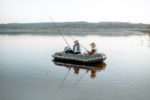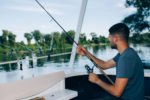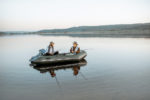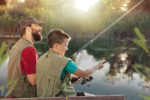How To Read a Moocor Fish Finder When You’ve Never Used One

One quick search online will show you that the market is booming with portable and compact fish finders.
You’ll also notice that many anglers have moved past the traditional ways of fishing to adopt a more versatile practice.
This includes moving on from conventional fish finders that needed to be installed into the vessel, which limited them to one form of fishing, to using portable versions.
For the most part, fish finders are an expensive piece of equipment.
Yet, with portable fish finders, such as the one by Moocor, you can enjoy multiple types of fishing adventures using just this one device.
What’s more, learning how to read a Moocor fish finder is easier than you think.
About Moocor
Moocor prides itself on developing some cutting-edge technologies related to marine navigation.
The company’s rich history represents its Japanese and Taiwanese roots, where most of the technology comes from.
Although the company designs and develops a variety of fishing products, the Moocor fish finders are its most valued and sought-after product.
The professional-grade build is supported by advanced technology that has revolutionized the fish finder industry.
Compared to traditional models, which cannot be moved once installed, you will definitely like the compact and portable nature of Moocor fish finders.
When To Use a Moocor Fish Finder
To read a Moocor fish finder, you must first acquaint yourself with its compatibility with different types of fishing.
A typical Moocor fish finder is a powerful tool when it comes to identifying game fish and charting the surface area around and near your vessel.
Because of its portable and compact nature, you can use it in a variety of settings and employ its expertise in different fishing adventures.
Here are some of the common types of fishing where you can use a Moocor fish finder:
When Ice Fishing
The technology used in a Moocor fish finder can withstand varying temperatures, even when ice fishing.
Its sturdy and robust body is designed to accommodate ice fishing expeditions.
The portable and compact camera lets you easily suspend it into holes made on the frozen lake.
Whether you are an avid ice finishing angler or know someone who is, the Moocor fish finder can make for a great gift.
When Kayak Fishing
Among many portable fish finders, the ones by Moocor are known for their versatile nature.
What’s interesting about them is that they do not take up much space, making them a great companion during kayak fishing trips.
While kayak fishing allows for remarkably close proximity to nature, a reliable fish finder helps you peek into the world below.
When Dock Fishing
Besides ice fishing and kayak fishing, we found the Moocor fish finder to be a great companion during pier or dock fishing.
You can easily use it in varying water conditions without affecting its efficiency.
Regardless if you’re fishing by a freshwater lake or a ravine along the sea, the device’s ability to identify game fish will never be compromised.
One of the best features of dock fishing with a Moocor fish finder is that it allows you to understand the topography in the surrounding area.
Since the area around most docks is considerably shallower, there is often a chance of getting your hook stuck in unsuitable situations.
However, with HD visuals, not only can you identify potential catch in the area but also be on the lookout for unfavorable circumstances.
When Boat Fishing
Although the Moocor may not be the best fish finder for trolling purposes, it still manages to capture some great data during stationary boat fishing.
It is primarily designed to allow users to observe the environment beneath their vessels in HD quality. Therefore, a moving vessel may result in distorted data.
How To Read a Moocor Fish Finder
Unlike traditional fish finders, the Moocor fish finder utilizes an underwater camera to capture and project images to the HD LCD monitor.
The real-time images captured from the water bed help provide direct insight into the activities going on below deck.
However, the Moocor fish finder is similar to other fish finders with regard to its display features.
Therefore, the best way to learn how to read a Moocor fish finder is by understanding the basic features one should look out for.
Here are some things to keep in mind that will help you operate your Moocor fish finder easily.
1. Tracking Depth Levels
A typical Moocor fish finder will help track the depth of the region underneath the vessel in two ways:
- Using the camera’s 120-degree wide-angle, which will capture the depth levels in the surrounding in both horizontal and vertical capacities
- Using the long extending cable of the portable camera, which provides depth-related readings in relation to the camera’s position
In both cases, the reading is displayed on the HD LCD monitor in meters and feet, which is in line with other fish finders.
This is particularly helpful for seasoned anglers who have prior experience with reading fish finders.
Also, while traditional fish finders have a depth sensor integrated into the transducer, the one by Moocor judges the depth levels via the camera integrated into the water.
The data collected for depth readings are displayed on the monitor in the header strip.
2. Inbuilt Speedometer
Almost every fish finder has an inbuilt speedometer. However, the level of performance may vary among these different models.
Despite this, they are still able to produce preliminary data to help understand the surroundings and map game fish in the region.
With the Moocor fish finder, the lack of sonar technology makes tracking speed levels a bit difficult.
The camera extended into the water body has some preliminary capacity to capture speed levels, but it may not be able to do it at high precision.
We recommend trying out the speed feature in a variety of water and fishing settings to determine the level of precision.
The speed is displayed on the HD LCD monitor in the header strip given on the top.
3. HD LCD Display
Like every display, you will find that the monitor has a user-friendly interface that provides all the necessary information in the most convenient manner.
Here are some common techniques that will help you read the display:
- The data on the display is most comprehensible when read from right to left.
- If you are seeking out the most recent data, the far-right side is the place to look.
- The camera provides raw footage of the regions around the vessel as well as through frequency mapping.
When in frequency mapping mode, the thicker lines represent structures in the surrounding.
- The display is colored but can be changed to grey-scale if and when required.
- The wide 120-degree angle of the camera allows users to monitor their surrounding areas by tilting it horizontally or vertically.
- The monitor’s built-in sun visor with background LED lighting allows for easy viewing in dim settings.
- The length of the cable submerged into the water is also available on the LCD.
- The monitor lets users remotely turn on infrared scanning and night lights to capture nighttime raw footage.
- The 1000TVL camera ensures an HD level video and primetime monitoring.
- You can also check the camera’s battery levels and switch on power-saving mode if prompted with a low battery.
- Users can choose one of four built-in time zones for the display.
4. Chart-Plotting
Like most fish finders, the one by Moocor also enables tracking your surrounding areas and mapping your way forward.
However, its unique ability to provide HD images of the surrounding underneath is an often lacking feature in other fish finder displays.
The display lets you map fish clusters as well as structural changes in the area, and the memory function helps keep track of previous mappings.
We recommend chart-plotting via the split-screen function to help you map and identify game fish in prime time.
5. Focused Scanning
While traditional fish finders allow users to zoom into specific regions up to 10 feet, the Moocor fish finder’s camera has a dual utility.
For starters, it can easily extend up to 15 meters into the water, allowing for a better 120-degree wide visual.
After reaching maximum capacity, users can zoom in and out to observe underwater wildlife and structural contours.
When used in combination with the temperature feature, the camera helps identify cold and warm pockets within the waterbed.
These are prime game fish regions, allowing users to target their fishing energies accordingly.
We recommend that you don’t use the zoom function in murky algae-infested surroundings, as it will hinder the readings collected.
Reading a Moocor Fish Finder
The best way to learn to read any fish finder is to apply the information you have gained from the user manual and other self-help resources.
The Moocor fish finder’s display utilizes a user-friendly interface, helping users pick up on different features easily.
Moreover, if you have any prior knowledge or experience with portable fish finders, reading the Moocor fish finder will be a piece of cake.
We recommend testing out the camera in a variety of different water settings and with different fishing types to gain a better sense of its utility.




